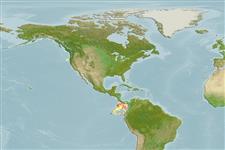Classification / Names
Noms communs | Synonymes | Catalog of Fishes(Genre, Espèce) | ITIS | CoL | WoRMS | Cloffa
>
Ophidiiformes (Cusk eels) >
Ophidiidae (Cusk-eels) > Neobythitinae
Etymology: Porogadus: Greek, poros = porous + Latin, gadus = a fish, cod? (Ref. 45335).
More on author: Garman.
Environment: milieu / climate zone / depth range / distribution range
Écologie
marin bathydémersal; profondeur 245 - 3300 m (Ref. 125143), usually 1800 - 3300 m (Ref. 125143). Deep-water; 10°N - 0° (Ref. 125143)
Eastern Pacific.
Taille / Poids / Âge
Maturity: Lm ? range ? - ? cm
Max length : 46.5 cm SL mâle / non sexé; (Ref. 125143)
Description synthétique
Morphologie | Morphométrie
This species is distinguished by the following characters: precaudal vertebrae 17-19; lower first gill arch with long gill rakers 11-13; pectoral-fin rays 19-22; HL:HD 1.81-2.08; in small specimens, head spines strong, while in in large specimens short and poorly extruding, present on ethmoidal, lacrimal, prefrontal (weak), interorbital (weak), supraorbital (weak in large specimens), sphenotic, 5th infraorbital, supratemporal (absent in large specimens), inner and outer posttemporal (absent in large specimens), inner and outer preopercular rims (absent in large specimens); opercular spine is sharp, strong, extruding; maxilla with no or few scales at rear; lower lateral line pores until beginning of anal fin 22-24; vomer with a broad dentition patch
(3-9 rows of teeth); palatines with broad dentition patch (2-11 rows of teeth); otolith with separate ostial and caudal colliculi indicated by ventral incision; OL:OH = 1.75-2.1; OL:TCL = 1.8-1.9 (Ref. 125143).
Rare species (Ref. 34024). This species ventures out for about 800 km from the continental break and occurs primarily between 1800 and 3300 m but two specimens were caught in very shallow water at 245 m or near the surface. The reason for the unusual shallow catches are not known (Ref. 125143). Reproductive strategy possibly similar to other members of this family featuring oviparity, with oval pelagic eggs floating in a gelatinous mass (Ref. 205).
Life cycle and mating behavior
Maturité | Reproduction | Frai | Œufs | Fécondité | Larves
Schwarzhans, W.W. and P.R. Møller, 2021. Revision of the ‘dragon-head’ cusk eels of the genus Porogadus (Teleostei: Ophidiidae), with description of eight new species and one new genus. Zootaxa 5029(1):001-096. (Ref. 125143)
Statut dans la liste rouge de l'IUCN (Ref. 130435)
Menace pour l'homme
Harmless
Utilisations par l'homme
Pêcheries: sans intérêt
Plus d'informations
Noms communsSynonymesMétabolismePrédateursÉcotoxicologieReproductionMaturitéFraiRassemblement de ponteFéconditéŒufsDéveloppement de l'œuf
Taille/ÂgeCroissanceLongueur-poidsLongueur-longueurFréquences de longueursMorphométrieMorphologieLarvesDynamique des populations larvairesRecrutementAbondanceBRUVS
RéférencesAquacultureProfil d'aquacultureSouchesGénétiqueElectrophoresesHéritabilitéPathologiesTraitementNutrientsMass conversion
CollaborateursImagesStamps, Coins Misc.SonsCiguateraVitesseType de nageSurface branchialeOtolithesCerveauxVision
Outils
Articles particuliers
Télécharger en XML
Sources Internet
Estimates based on models
Preferred temperature (Ref.
123201): 2.6 - 3.1, mean 2.7 °C (based on 6 cells).
Phylogenetic diversity index (Ref.
82804): PD
50 = 0.5001 [Uniqueness, from 0.5 = low to 2.0 = high].
Bayesian length-weight: a=0.00380 (0.00165 - 0.00876), b=3.14 (2.93 - 3.35), in cm total length, based on LWR estimates for this (Sub)family-body shape (Ref.
93245).
Niveau trophique (Ref.
69278): 3.7 ±0.6 se; based on size and trophs of closest relatives
Résilience (Ref.
120179): Milieu, temps minimum de doublement de population : 1,4 à 4,4 années (Preliminary K or Fecundity.).
Fishing Vulnerability (Ref.
59153): Moderate vulnerability (43 of 100).
